Devonshire House Skin Clinic
[9 miles from Fairlop]
Welcome to the Award-Winning Devonshire House Skin Clinic, Our Pioneering Skin Health Treatment Clinic.[READ MORE]
24a High Street, Brentwood, CM14 4AB

In our comprehensive list, you will find all the best, trustworthy Cosmetic Skin Camouflage clinics near Fairlop.
We only allow verified and accredited clinics that are registered with the appropriate governing bodies so you can TRUST the experts at ConsultingRoom.com to find your ideal clinic in Fairlop.
For information on Cosmetic Skin Camouflage please Click Here to view our comprehensive treatment FAQ, or to book a consultation contact your chosen clinic from the list directly.
[9 miles from Fairlop]
Welcome to the Award-Winning Devonshire House Skin Clinic, Our Pioneering Skin Health Treatment Clinic.[READ MORE]
24a High Street, Brentwood, CM14 4AB
[19 miles from Fairlop]
Dr Soumya Lanka MBBS, MRCGP, DRCOG, DFFP, DCH is a fully qualified GP and Aesthetic Doctor from a Surgical background. She has worked at the prestigious St Andrews burns and plastics unit at Broomfiel...[READ MORE]
Skin Sense,, 27 Springfield Lyons Approach, Chelmsford, CM2 5LB
Cosmetic Skin Camouflage FAQ
Skin camouflage is defined as being, “a simple solution for complex problems and is generally accepted that it can be a vital tool during the early stages of a person’s rehabilitation and adjustment to an altered image. However, for others, using skin camouflage may need to be considered as a long-term process."
Skin camouflage was pioneered during the Second World War to help aircrews after they had undergone plastic surgery procedures.
During the 1950’s Joyce Allsworth researched and implemented the concept of skin camouflage within the United Kingdom. Joyce Allsworth was instrumental in training members of the British Red Cross in camouflage and was involved in setting up the clinics in hospitals around the country.
This work was complemented by a comprehensive training programme designed to increase the number of graduates in this specialist area by training medical professionals, make-up artists and beauty therapists too. The pioneering work by Joyce Allsworth has resulted in a network of practitioners being set up internationally.
A skin camouflage consultation takes approximately one hour, during which time the specially formulated creams are tested directly onto your skin to find an acceptable match to your natural colour. They are not chosen from a colour match card. Loose powder is then used to set and stabilise the cream.
During the consultation you will be taught how to effectively apply and remove the camouflage, and also advised how not to accidentally disturb the camouflage during wear. You will also be given information on how and where you can obtain the agreed products for your use.
You will be able to ask the practitioner lots of questions and try out various creams until you agree a product best suited for your skin condition and lifestyle.
Skin camouflage techniques can be used over a number of non-infectious skin conditions, however, always seek medical confirmation on appropriate use. These include:
Examples of suitable skin conditions for skin camouflage would include:
Application of the skin camouflage creams does not hurt.
It is unlikely that you will develop an allergic reaction to prescription brands of skin camouflage obtained from a reliable source. However, you are strongly advised to consult your doctor if you have any allergy or sensitivity resulting from skin camouflage products. You must advise the skin camouflage practitioner of any known allergy or sensitivity to the ingredients (such as lanolin) when making an appointment for consultation.
Application of skin camouflage must not be over any broken, inflamed or weeping skin (e.g., eczema), neither should it be applied over birthmarks such as capillary and superficial haemangomas (strawberry birth marks).
Skin camouflage is contra-indicated and cannot be applied over conditions classified as:
Topical medication and ointments as well as sunscreen may be applied under and before the camouflage, and decorative make-up (e.g., blusher) can be applied over the set camouflage without any ill effect.
Skin camouflage is suitable for men, women and children, irrespective of ethnic skin colour and religion.
Skin camouflage may be suitable for school aged children (pre-puberty), if deemed appropriate by a doctor, but it should never be used on babies to cover birthmarks for example, unless at the specific request of a medical practitioner.
It is recommended that you see a specialist in skin camouflage as they can help you decide which product(s) suit you best and teach you how to apply them. This person may or may not also be a medical professional.
Some NHS hospitals provide this service as part of the patients’ care plan (for example, by a nurse on a burns unit) and in Out Patient Clinics (such as Oncology, Dermatology, Maxillo-Facial, Pharmacy, etc).
We suggest you choose a practitioner who is a member of and has received training provided by an established organisation of skin camouflage practitioners such as;
A consultation will usually take approximately one hour - for which there will normally be a charge. This charge will not include the cost of any creams for your future use. One visit however is usually sufficient to teach you how to conceal the blemish.
Some camouflage creams are available through the NHS and can be prescribed by your doctor.
The products can also be ordered at local pharmacies or purchased directly from the manufacturers or distributors.
The prices of creams will vary according to the brand and type used.
There are five main brands of skin camouflage creams; Covermark , Dermablend , Dermacolor, Keromask and Veil. However, as skin colours and conditions differ it is advisable to seek professional help to find the right brand for you.
Having a non-infectious skin condition, scarring or an unwanted tattoo is not just a physical problem. It often affects how you feel about yourself, lowering both confidence and self esteem. It may even change or affect relationships with your family, friends and work colleagues. It is therefore possible to change your life by using skin camouflage.
Skin camouflage represents a quick, non-invasive topical application of specially formulated products that can help reduce a person’s distress from intrusive questioning, stares and unwarranted comments.
Whether you choose to use it every day, allowing you to work and enjoy normal social activities without the worry of feeling self conscious, or just use it for special occasions; it can make all the difference.
You can simply purchase the products yourself, but we would always recommend you see a specialist in skin camouflage techniques. This consultant may be a non-medical practitioner, such as a beauty therapist or a make-up artist.
Please note that results vary and are dependent upon both the patient and the skill of the individual practitioner.
We are grateful to the association known as British Association of Skin Camouflage (dissolved 2023) for allowing us to include images that illustrate before and after the application of skin camouflage in a variety of cases.
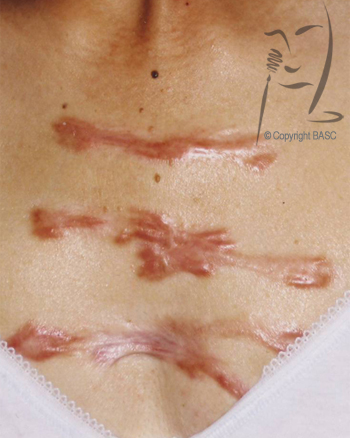 |
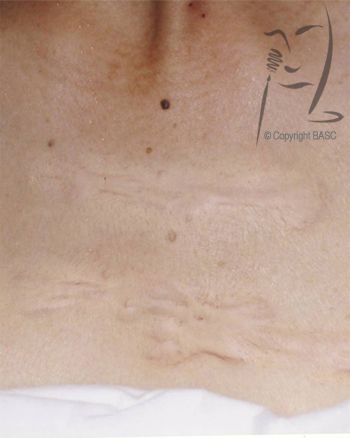 |
Keloid to chest. Scarring remains unaltered, but the erythema becomes less noticeable.
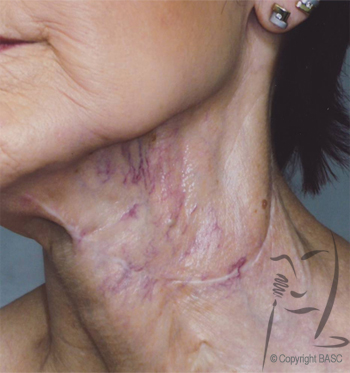 |
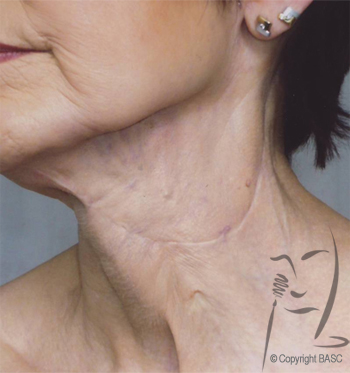 |
Vascular disturbance & atrophic scar to neck. Vascular malfunction following tumour removal, patient did not want 100% cover, just sufficient to make the neck less noticeable.
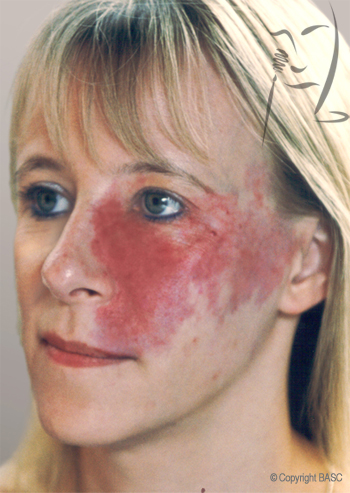 |
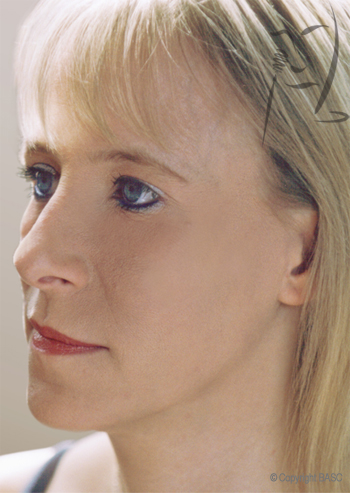 |
Port Wine Stain to face. Decorative make up can be applied over set skin camouflage (note, complementary green primer not required for this stain)
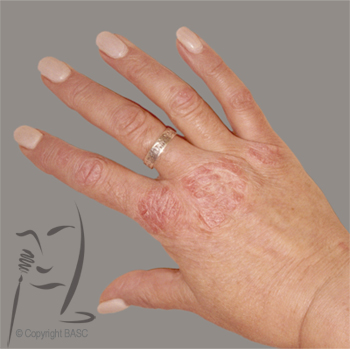 |
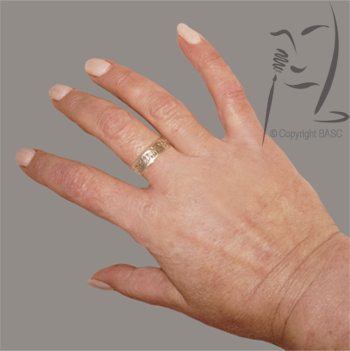 |
Psoriasis on hand. Fixing spray will help keep camouflage to back of hands and fingers, but is not recommended to ventral.
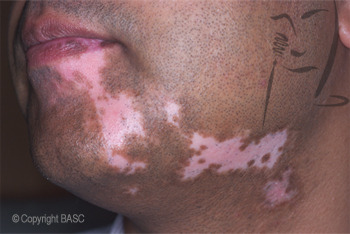 |
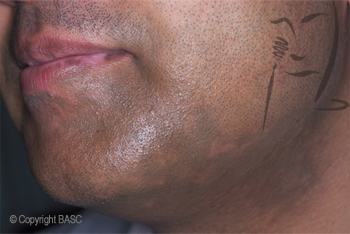 |
Leucoderma to male chin. Fake beard stubble, using a camouflage crème, has also been applied.
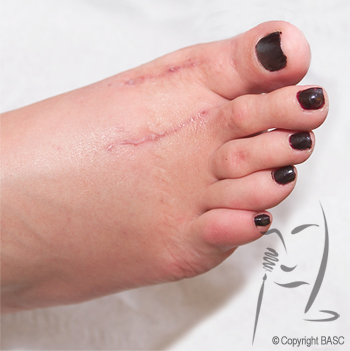 |
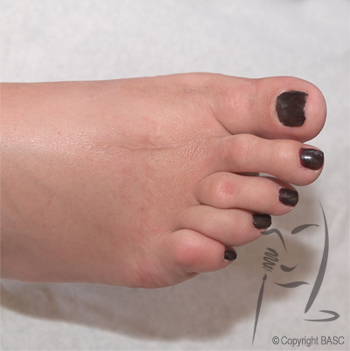 |
Foot with hypertrophic scar. Allows person to wear open shoes or be barefoot.
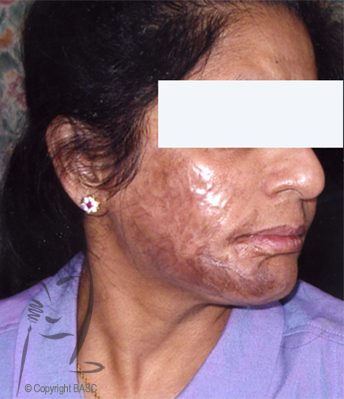 |
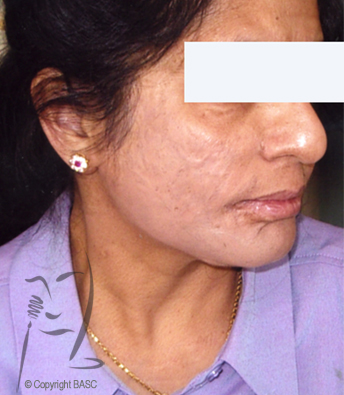 |
Burn Injury to face. The camouflage area will appear more pale when viewed as a photographic image when the flash mechanism is activated, however this can be minimised by selecting products that do not contain titanium dioxide and/or iron oxide.
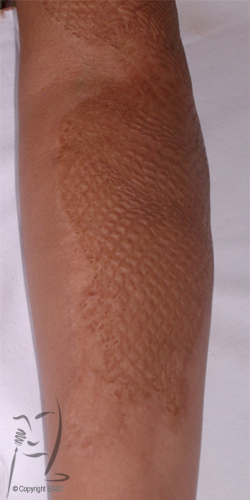 |
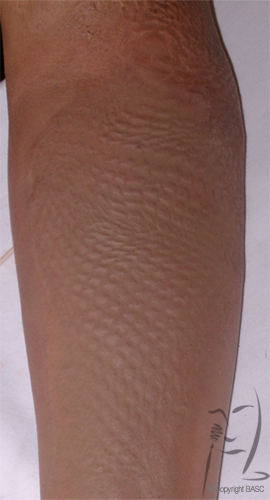 |
Scarring from mesh graft, required following burn injury
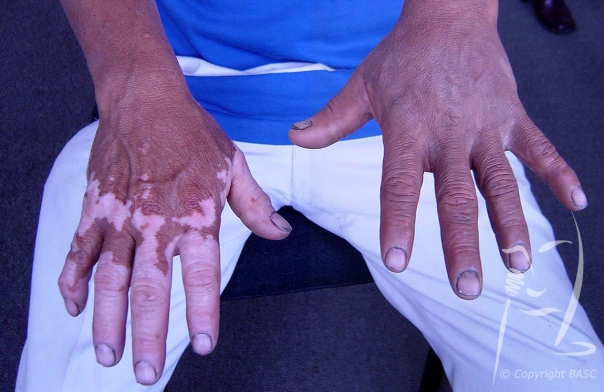
Vitiligo on both hands - left hand with camouflage applied. Copyright BASC Member 2160.
Please note all images are published with kind permission from The British Association of Skin Camouflage (dissolved 2023) , are under the BASC Copyright and cannot be copied or reproduced without their permission